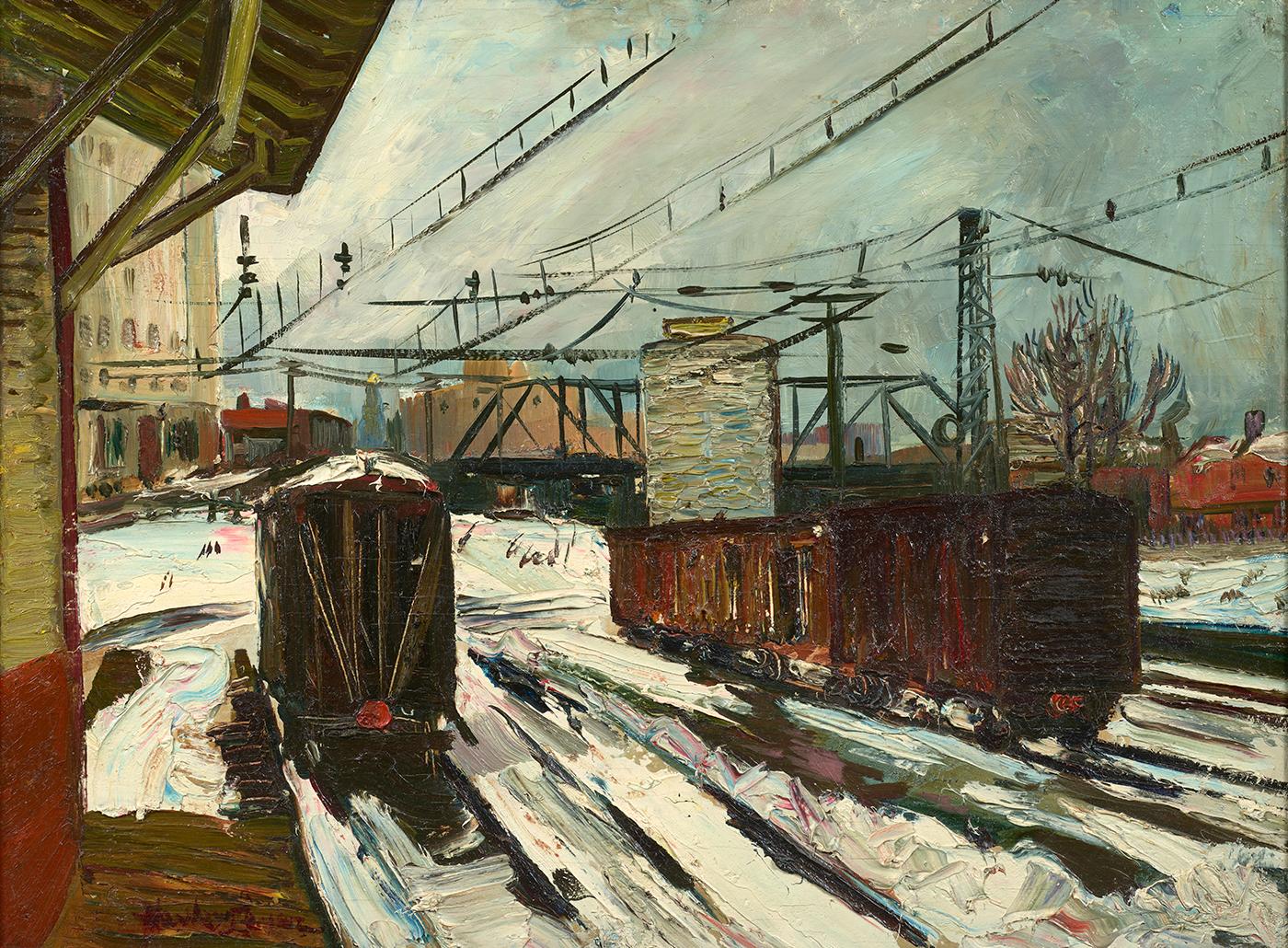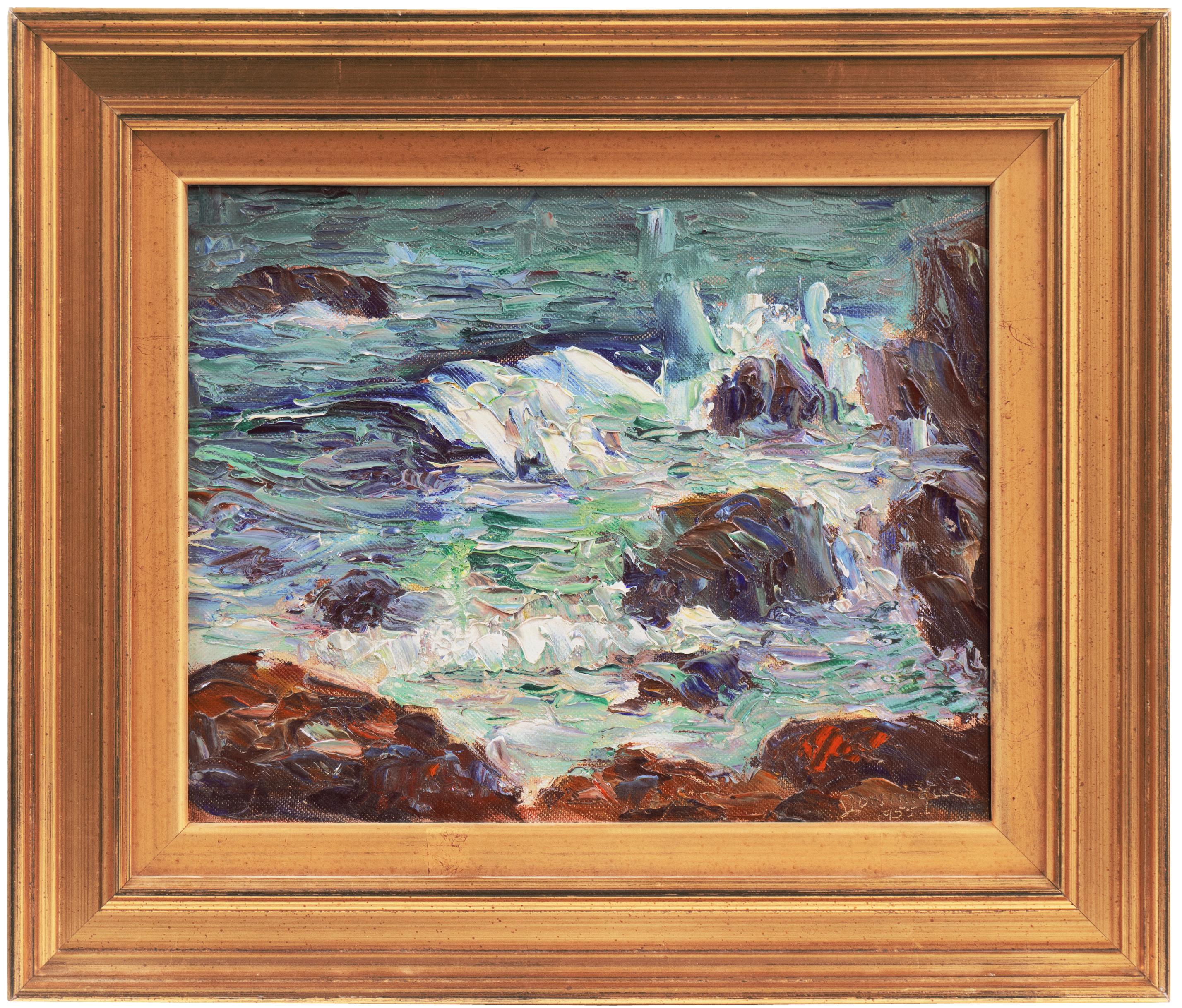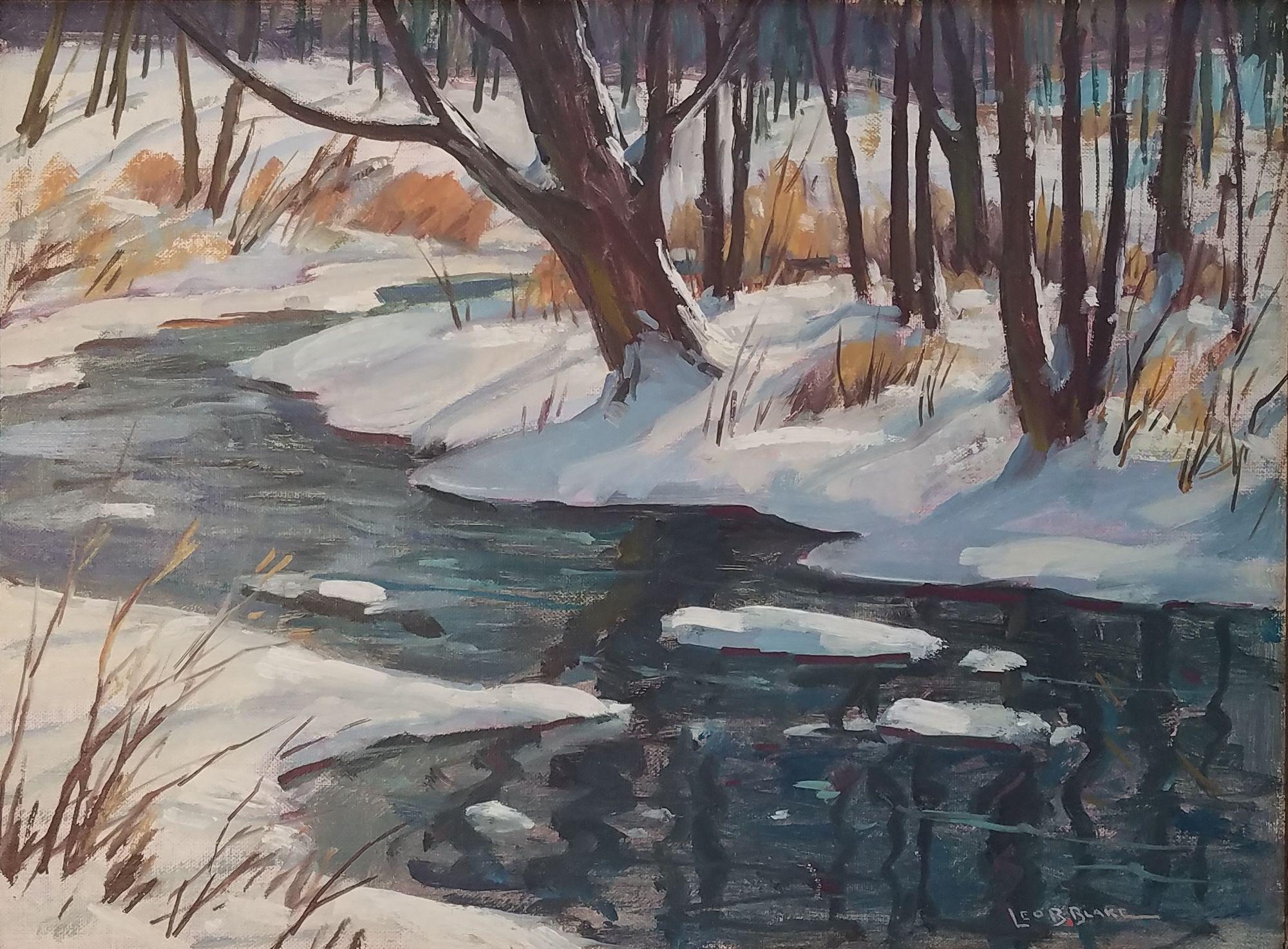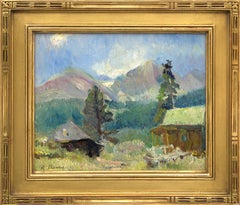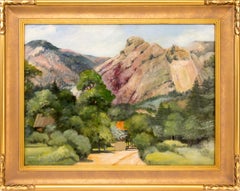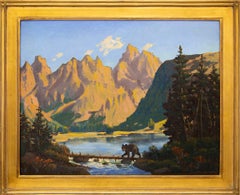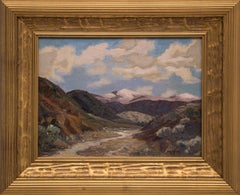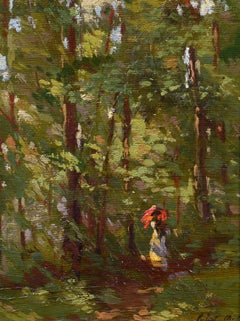Items Similar to Gunnison, Colorado 1940s Modernist Mountain Landscape Painting, Green, Blue, Red
Video Loading
Want more images or videos?
Request additional images or videos from the seller
1 of 14
Muriel SwansonGunnison, Colorado 1940s Modernist Mountain Landscape Painting, Green, Blue, Red1947
1947
About the Item
1940s modernist mountain landscape painting, near Gunnison, Colorado with a white farmhouse and out buldings and trees in a meadow/valley with mountains in the background. Painted in a somewhat primitive, naive, modernist style in colors of green, brown, red, yellow, purple, blue and white. Presented in a vintage rustic wood frame, outer dimensions measure 18 ¾ x 22 ¾ x 1 ¾ inches. Image size is 15 ¾ x 20 inches.
Painting is in good vintage condition - please contact us for a detailed condition report.
Expedited and international shipping is available - please contact us for a quote.
- Creator:Muriel Swanson (1930, American)
- Creation Year:1947
- Dimensions:Height: 18.75 in (47.63 cm)Width: 22.75 in (57.79 cm)Depth: 1.75 in (4.45 cm)
- Medium:
- Movement & Style:
- Period:
- Framing:Frame IncludedFraming Options Available
- Condition:very good vintage condition.
- Gallery Location:Denver, CO
- Reference Number:Seller: DCG-249831stDibs: LU2738045512
About the Seller
5.0
Gold Seller
Premium sellers maintaining a 4.3+ rating and 24-hour response times
Established in 1979
1stDibs seller since 2013
286 sales on 1stDibs
Typical response time: 1 hour
- ShippingRetrieving quote...Shipping from: Denver, CO
- Return Policy
Authenticity Guarantee
In the unlikely event there’s an issue with an item’s authenticity, contact us within 1 year for a full refund. DetailsMoney-Back Guarantee
If your item is not as described, is damaged in transit, or does not arrive, contact us within 7 days for a full refund. Details24-Hour Cancellation
You have a 24-hour grace period in which to reconsider your purchase, with no questions asked.Vetted Professional Sellers
Our world-class sellers must adhere to strict standards for service and quality, maintaining the integrity of our listings.Price-Match Guarantee
If you find that a seller listed the same item for a lower price elsewhere, we’ll match it.Trusted Global Delivery
Our best-in-class carrier network provides specialized shipping options worldwide, including custom delivery.More From This Seller
View All1920s Landscape Oil Painting, Cabin Near Estes Park, Colorado, Green, Blue, Gray
By Randall Davey
Located in Denver, CO
This original oil painting by renowned American artist Randall Vernon Davey (1887-1964) was painted circa 1927 and depicts a serene scene of a wood cabin near Estes Park, Colorado. I...
Category
Mid-20th Century American Impressionist Landscape Paintings
Materials
Oil, Board
1930s Summer Landscape Oil Painting, Framed Mountain Landscape Rocks Trees House
Located in Denver, CO
Oil on board painting by Sister Mary Norbert from 1938 of a summer mountain landscape with lush trees and a farm house. Colors of green, brown, purple, blu...
Category
1930s American Impressionist Landscape Paintings
Materials
Oil, Board
Little Bear, 1950s Framed Traditional Western Mountain Landscape Painting
By Harold Vincent Skene
Located in Denver, CO
Little Bear is a traditional Landscape painting by Harold Skene (1883-1978). The mid 20th century painting depicts a brown or black bear crossing on a log...
Category
Mid-20th Century American Impressionist Animal Paintings
Materials
Oil, Board
Western Mountain Landscape Painting, Vintage 1940s, Brown, Blue, Purple, White
By Turner Messick
Located in Denver, CO
Original oil painting of a western mountain landscape, likely California or Colorado by Turner B. Messick (1878-1952), with snow covered pea...
Category
1940s American Impressionist Landscape Paintings
Materials
Oil, Board
1920s Colorado Western Landscape Oil Painting, Blue Sky, Buttes, & Mountain Art
By Charles Ragland Bunnell
Located in Denver, CO
This original 1926 signed oil painting by 20th cenutry artist Charles Ragland Bunnell (1897-1968) beautifully captures the expansive Colorado prairie landscape. Created while Bunnell...
Category
1920s American Impressionist Landscape Paintings
Materials
Board, Oil
Pikes Peak, 1940s Colorado Mountain Landscape in Autumn, Tempera Painting
By Charles Ragland Bunnell
Located in Denver, CO
Original vintage 1941 Colorado landscape painting with autumn leaves and Pikes Peak blanketed in snow by Charles Bunnell (1897-1968). Inscribed verso, "To Laura, November 22, 1941", egg tempera on board. Signed by the artist in the lower left corner and titled verso. Presented in a custom frame, outer dimensions measure 15 ½ x 19 ¼ x 1 ¼ inches. Image size is 7 ¾ x 11 inches
About the Artist:
Artist and teacher, Charles ("Charlie") Bunnell worked in a variety of styles throughout his career because as an artist he believed, "I’ve got to paint a thousand different ways. I don’t paint any one way." At different times he did representational landscapes while concurrently involved with semi- or completely abstract imagery. He was one of a relatively small number of artists in Colorado successfully incorporating into their work the new trends emanating from New York and Europe after World War II. During his lifetime he generally did not attract a great deal of critical attention from museums, critics and academia. However, he personally experienced a highpoint in his career when Katherine Kuh, curator at the Art Institute of Chicago, personally chose one of his paintings - Why? - for its large exhibition of several hundred examples of abstract and surrealist art held in 1947-48, subsequently including it among the fifty pieces selected for a traveling show to ten other American museums.
An only child, Bunnell developed his love of art at a young age through frequent drawing and political cartooning. In high school he was interested in baseball and golf and also was the tennis champion for Westport High School in Kansas City. Following graduation, his father moved the family to Denver, Colorado, in 1916 for a better-paying bookkeeping job, before relocating the following year to Colorado Springs to work for local businessman, Edmond C. van Diest, President of the Western Public Service Company and the Colorado Concrete Company. Bunnell would spend almost all of his adult life in Colorado Springs.
In 1918 he enlisted in the United States Army, serving in the 62nd Infantry Regiment through the end of World War I. Returning home with a 10% disability, he joined the Zebulon Pike Post No. 1 of the Disabled American Veterans Association and in 1921 used the benefits from his disability to attend a class in commercial art design conducted under a government program in Colorado Springs. The following year he transferred to the Broadmoor Art Academy (founded in 1919) where he studied with William Potter and in 1923 with Birger Sandzén. Sandzén’s influence is reflected in Bunnell’s untitled Colorado landscape (1925) with a bright blue-rose palette.
For several years thereafter Bunnell worked independently until returning to the Broadmoor Art Academy to study in 1927-28 with Ernest Lawson, who previously taught at the Kansas City Art Institute where Bunnell himself later taught in the summers of 1929-1930 and in 1940-41. Lawson, a landscapist and colorist, was known for his early twentieth-century connection with "The Eight" in New York, a group of forward-looking painters including Robert Henri and John Sloan whose subject matter combined a modernist style with urban-based realism. Bunnell, who won first-place awards in Lawson’s landscapes classes at the Academy, was promoted to his assistant instructor for the figure classes in the 1928-29 winter term. Lawson, who painted in what New York critic James Huneker termed a "crushed jewel" technique, enjoyed additional recognition as a member of the Committee on Foreign Exhibits that helped organize the landmark New York Armory Exhibition in 1913 in which Lawson showed and which introduced European avant-garde art to the American public.
As noted in his 1964 interview for the Archives of American Art in Washington, DC, Bunnell learned the most about his teacher’s use of color by talking with him about it over Scotch as his assistant instructor. "Believe me," Bunnell later said, "[Ernie] knew color, one of the few Americans that did." His association with Lawson resulted in local scenes of Pikes Peak, Eleven Mile Canyon, the Gold Cycle Mine near Colorado City and other similar sites, employing built up pigments that allowed the surfaces of his canvases to shimmer with color and light. (Eleven Mile Canyon was shown in the annual juried show at the Carnegie Institute in Pittsburgh in 1928, an early recognition of his talent outside of Colorado.) At the same time, he animated his scenes of Colorado Springs locales by defining the image shapes with color and line as demonstrated in Contrasts (1929). Included in the Midwestern Artists’ Exhibition in Kansas City in 1929, it earned him the gold medal of the Kansas City Art Institute, auguring his career as a professional artist.
In the 1930s Bunnell used the oil, watercolor and lithography media to create a mini-genre of Colorado’s old mining towns and mills, subject matter spurned by many local artists at the time in favor of grand mountain scenery. In contrast to his earlier images, these newer ones - both daytime and nocturnal -- such as Blue Bird Mine essentially are form studies. The conical, square and rectangular shapes of the buildings and other structures are placed in the stark, undulating terrain of the mountains and valleys devoid of any vegetation or human presence. In the mid-1930s he also used the same approach in his monochromatic lithographs titled Evolution, Late Evening, K.C. (Kansas City) and The Mill, continuing it into the next decade with his oil painting, Pikes Peak (1942).
During the early 1930s he studied for a time with Boardman Robinson, director of the Broadmoor Art Academy and its successor institution, the Colorado Springs Fine Arts Center from 1930 to 1947. In 1934 Robinson gave him the mural commission under the Public Works of Art Project (PWAP) for West Junior High School in Colorado Springs, his first involvement in one of several New Deal art...
Category
1930s American Impressionist Landscape Paintings
Materials
Egg Tempera, Board
You May Also Like
Sparse Forest Scene
By William McGregor Paxton
Located in Fredericksburg, VA
Sparse Forest Scene by William McGregor Paxton is a testament to the artist's mastery of light, atmosphere, and nuanced detail. Known for his contributions to American Impressionism,...
Category
Early 20th Century American Impressionist Landscape Paintings
Materials
Oil, Board
Train Station in Snow
By Hayley Lever
Located in New York, NY
Signed lower left: Hayley Lever
Category
Mid-20th Century American Impressionist Landscape Paintings
Materials
Oil, Board
Afternoon Stroll, American Impressionist, Figure on Forest Path, Landscape
Located in Wiscasset, ME
Juliet M. White was born in Philadelphia in 1880. She studied at the Philadelphia School of Design for Women, which became the largest art school for women in the United States. Its ...
Category
20th Century American Impressionist Figurative Paintings
Materials
Canvas, Oil, Board
'Breaking Waves, Laguna Beach' California Coast, Santa Barbara, LACMA, SFAA, CWS
By John August Dominique
Located in Santa Cruz, CA
Inscribed lower right, 'Dominique' for John Augustus Dominique (American, 1893-1994) and dated 1955. Titled, verso, 'Laguna Coast' and bearing old galler...
Category
1950s American Impressionist Landscape Paintings
Materials
Oil, Board
"The Green Parasol, " Henry Hannig, American Impressionist, Woman in Beach Scene
By Henry Hannig
Located in New York, NY
Henry Charles Hannig (1883 - 1948)
The Green Parasol
Oil on canvas mounted on board
6 x 7 3/4 inches
Provenance:
R.H. Love Galleries, Chicago, Illinois
Private Collection, Lake Orion, Michigan
Hannig, born in Hirschberg, Germany on 27 February 1883, came to America with his parents at the age of seven. He attended school in the southwest suburbs before the family settled in Chicago. Young Henry enrolled in the Chicago Academy of Fine Arts where Lawton Parker became his mentor. He made ends meet by working in industrial design and illustration.
By 1908 he was a pupil in the School of the Art Institute of Chicago where students followed the traditional European drawing curriculum, beginning with the copying of master engravings and drawing after plaster casts, then concentrating on the nude figure. Students worked toward the goal of winning various academic prizes. One of Hannig's fellow students was Louis Ritman...
Category
1910s American Impressionist Figurative Paintings
Materials
Canvas, Oil, Board
"Berkshires Winter Landscape, " Leo Blake, Snowy Stream in Massachusetts
By Leo Blake
Located in New York, NY
Leo B. Blake (1887 - 1976)
Berkshires Winter landscape, Massachusetts, circa 1952-53
Oil on canvasboard
12 x 16 inches
Signed lower right
Provenance:
Private Collection, Massachuset...
Category
1950s American Impressionist Landscape Paintings
Materials
Oil, Board
$4,000 Sale Price
20% Off
Recently Viewed
View AllMore Ways To Browse
Vintage 1940s Paint Colors
Primitive Blue Wood
Picasso 1969 Poster
Syrian Print
Vintage Television Cameras
Vintage Travel Los Angeles
1930s Fashion Drawing
Al Davis
Alexander Calder 1969 Lithograph
Andre Derain Original
Anthropomorphic Animals
Antique Rudolph
Art Deco Privacy Screen
British Caricature
Butterfly Screen
Castle Etching
Daisy Mccrackin
Drunk Art

